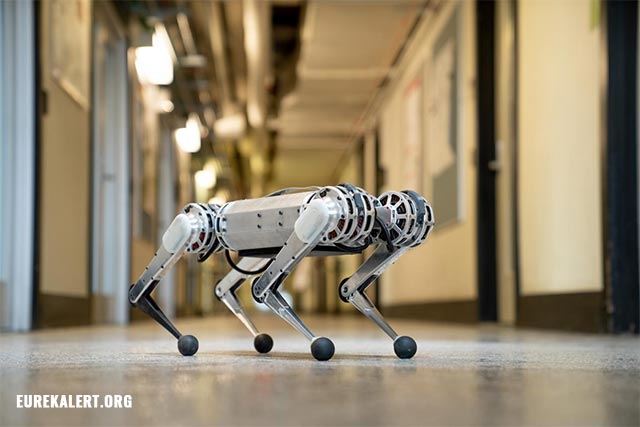Chinese four-legged robot sparks speculation that its makers stole US tech
04/16/2021 / By Virgilio Marin

Chinese company Unitree Robotics developed a four-legged robot that looked like the robotic dog that engineering company Boston Dynamics debuted in 2015. Unitree introduced its machine at the 2020 Consumer Electronics Show held in Las Vegas in January last year.
Called “Aliengo,” the Chinese robot is controlled by artificial intelligence (AI) and has advanced depth perception. It is extremely durable and can travel 10 feet per second, or around seven miles per hour. In a Twitter video shared on April 4, a number of Aliengo robots can be seen crouched down on the floor before springing up in unison to a squatting position.
NEW – Say hello to this squadron of Boston Dynamics look-alike robots – made by a Chinese robotics firm. pic.twitter.com/vjQ2Rs0mFi
— Disclose.tv 🚨 (@disclosetv) April 3, 2021
On the other hand, the four-legged machine of Boston Dynamics called “Spot,” can walk up to three miles per hour, see 360 degrees, climb terrain and avoid obstacles. It can also perform a number of programmed tasks, such as opening doors and dancing.
People who commented on the video noticed the resemblance between the two. Some accused China of “stealing” the American creation while others speculated that the design was “given.”
“That’s really what Chinese tech companies do best … copy and paste lower quality versions of Western-made technology,” wrote one person.
“Stolen? No. Given,” said another.
Some people also likened Aliengo to the killing machine on the movie “The Terminator.” Others compared the squadron on the video with the robotic army on the British television series “Black Mirror.” A 2017 episode from the show depicted humans running from murderous robots after the unexplained collapse of humanity. (Related: AI expert warns that military robots could go off the rails and wipe out the very people they are supposed to protect.)
A number of comments also raised the possibility that China would weaponize the technology. Last year, the Chinese army was reportedly preparing to deploy war robots armed with machine guns and other combat gear. The tracked robots were designed to traverse rugged or uneven terrain and operate as forward-positioned weapons for ground attacks.
But Unitree appeared to have envisioned Aliengo as a factory helper. The company designed the robot to carry up to 11 pounds of payload, which should make it suitable for warehouse work.
China is trying to steal American tech
Christopher Wray, director of the Federal Bureau of Investigation (FBI), told a conference last year that the agency had about 1,000 active investigations into attempted technology theft by China. John Brown, executive assistant director of the FBI’s National Security Branch, informed the same conference that the agency arrested 24 people embroiled in China-related cases in 2019 and 19 more as of February 2020.
As to how Beijing was stealing American technology, Wray revealed that the Communist state was exploiting academic openness by building “campus proxies” and establishing institutes on American campuses. According to the FBI, most of those who had been charged were Chinese government officials, business people and academics. Former American intel officers were also arrested.
Chinese espionage drove Washington to cancel the visas of more than 1,000 Chinese researchers and academics last September. Chad Wolf, then-acting secretary of Homeland Security, said that the move was to prevent Chinese nationals with ties to Beijing’s military-civil fusion strategy from stealing and appropriating sensitive research. (Related: New report shows China using students to steal American tech.)
Beijing has been spying on the U.S. for some time but appeared to have stepped up efforts in recent years. Data from the Center for Strategic and International Studies (CSIS), a Washington D.C.-based think tank that hosted the conference, showed that 73 percent of 137 publicly reported instances of Chinese-linked espionage against the U.S. since 2000 took place in the last decade.
The data, which excluded cases of intellectual property litigation and attempts to smuggle weapons or controlled technologies, also indicated that military and commercial technologies were the most common targets for theft.
According to CSIS senior vice president James Lewis, Chinese espionage expanded in part because China depends on western technology. Since legal avenues are closed, the country turns to espionage to obtain access.
China is working to become a leading manufacturer of advanced technology. In 2015, the Chinese government launched a ten-year program called “Made in China 2025” to catch up with – and eventually surpass – Western technological prowess. It is rapidly developing ten high-tech industries, including advanced robotics and AI, electric vehicles and next-generation telecommunications technology.
Learn more about China’s illegal efforts to beat the U.S. in the tech race at NationalSecurity.news.
Sources include:
Tagged Under: AI, AI weapons, American tech, artificial intelligence, Beijing, CCP, China, Chinese military, Chinese propaganda, Chinese spies, Chinese spying, communist China, Communist Party, crime, espionage, FBI, Federal Bureau of Investigation, future science, future tech, national security, robot jobs, robot takeover, Robot Wars, robotics, robots, technology, technology theft, terminators, traitors, treason, war, warfare, weapons
RECENT NEWS & ARTICLES
COPYRIGHT © 2020 CommunistChina.News
All content posted on this site is protected under Free Speech. CommunistChina.News is not responsible for content written by contributing authors. The information on this site is provided for educational and entertainment purposes only. It is not intended as a substitute for professional advice of any kind. CommunistChina.News assumes no responsibility for the use or misuse of this material. All trademarks, registered trademarks and service marks mentioned on this site are the property of their respective owners.




















